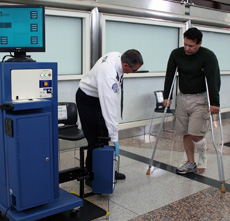CastScope
Innovation & Technology
Paperless Boarding Pass | Threat Image Projection | Trace Portals
Whole Body Imaging
TSA Begins Piloting of New CastScope Security System at Airport Checkpoints

TSA has begun using the new CastScope screening system and will deploy CastScope to 11 airports in 2008. CastScope deployment to airports will be based on the airport’s proximity to military hospitals or large rehabilitation facilities that serve amputees, sports events for disability groups, vacation destinations utilized by amputees and in airports that see large volumes of military severely injured.
The airports selected for the technology are San Antonio, Denver, Minneapolis, Atlanta, Washington-Dulles, Reagan National, Orlando, John. F. Kennedy, Los Angeles, Baltimore-Washington, and Phoenix. Among them they will receive 34 CastScope machines.
TSA piloted CastScope in 2007 at San Jose International Airport, Tampa International Airport, Nashville International Airport and Reagan National Airport. In the pilot phase, passengers with prosthetics, cast, or a brace participated on a voluntary basis.
TSA worked closely with special interest groups like the Amputee Coalition of America and others to determine best practices, operational suitability and modify the technology so that it best meets the needs of the traveling public.
CastScope provides security officers with a means to ensure that a cast or prosthetic does not contain a concealed threat while maintaining the dignity and privacy of the passenger.
To learn more about the CastScope, please see the frequently asked questions below:
Frequently Asked Questions
Q: What is the CastScope X-ray?
A: The CastScope uses backscatter technology to produce an X-ray image of casts, braces, heavy bandages, and/or prostheses, allowing TSA to quickly and non-invasively identify any potential threats.
Q: What is backscatter technology?
A: Backscatter scans a narrow, low-energy x-ray beam over the body surface. The reflection, or backscatter, of the beam is detected, digitized and displayed on a monitor. The high contrast image generated allows TSA to differentiate between articles such as braces, prosthetics, and external medical devices, and prohibited items.
Q: What is the purpose of the CastScope X-ray?
A: The CastScope was designed to supplement the walk-through and hand-held metal detectors for passengers with casts, braces, heavy bandages, or prosthetics that may alarm because of the metallic components of the devices by providing an X-ray image for TSA to assess concealed threats.
Q: How long does it take to be scanned by the CastScope?
A: Multiple scans will be necessary depending on type of device, location of device, size of device, and number of devices worn by the passenger. These factors will determine how long the scanning process will take, each scan takes approximately 3 seconds.
Q: What is the difference between backscatter x-rays and medical x-rays?
A: Backscatter x-rays only penetrate approximately ¼ of an inch before the rays are scattered, whereas medical X-rays transmit completely through the body. For comparison, the CastScope emits less than 10 microRem of radiation per scan and a typical medical X-ray emits 10,000 to 100,000 microRem per scan.
Q: How much radiation exposure is produced from 1 scan of the CastScope? Is it safe?
A: One scan is equivalent to approximately 10 microRem of radiation. This is equivalent to the exposure each person receives in about two minutes of airplane flight at altitude or each person receives every 15 minutes from naturally occurring background radiation.
The American National Standards Institute (ANSI) developed a standard for X-raying human subjects for security purposes using back-scatter X-ray technology. The National Council on Radiation Protection (NCRP) states that a person receiving 1000 microRem (100 scans) per year is still considered a negligible individual dose. In addition, the Food and Drug Administration (FDA) and NCRP have advised that the CastScope is safe to use on anyone ages 5 and up regardless of gender or any medical condition.
Q: How is it verified that the CastScope X-ray is in compliance with safety standards?
A: The device was designed to comply with the ANSI/HPS N43-17 standard and recommendations of the National Council on Radiation Protection and Measurement. Both standards detail procedures for measuring the radiation emissions from the source (scanning head). Certified personnel check the radiation emissions periodically per the procedures outlined by the ANSI and NCRP standards and recommendations.
Q: Can the radiation exposure from the CastScope X-ray cause cancer?
A: Exposure to low levels of ionizing radiation not exceeding those from the environment has not been shown to affect human health.
Q: Is screening using the CastScope intrusive?
A: Not at all. It is not necessary to raise or remove any article of clothing that may be covering the cast, brace, or prosthesis to image the area where the prosthetic, cast, or support brace are worn.
Q: Can the CastScope damage an advanced prosthetic (with integrated circuitry)?
A: No, the CastScope will not damage mature or state-of-the-art devices.
Q: Will CastScope screening damage implanted medical devices such as pacemakers, defibrillators, or bone growth simulators?
A: No. The CastScope does not emit a magnetic field and will not cause any adverse medical consequences to implanted medical devices or any other disability-related equipment.
Q: Who manufactures the CastScope?
A: The CastScope was designed by Spectrum San Diego, Inc. located in San Diego, CA.
Q: Has TSA consulted with any passengers with disabilities or disability-related organizations during the development or fielding of this technology?
A: Yes. As with all aspects that affect the disability population, TSA continues to work with its Disability Coalition of over 73 disability-related groups and organizations to ensure the CastScope integrates the needs of persons with disabilities. TSA has extended outreach efforts to include: preoperational studies by National Safe Skies Alliance and the Amputee Coalition of America (ACA), an ACA demonstration in Minneapolis, and a pilot demonstration in Reno in coordination with the Veterans of Foreign Wars Conference.


